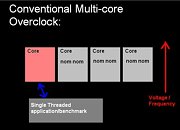- Joined
- Oct 9, 2007
- Messages
- 47,448 (7.50/day)
- Location
- Hyderabad, India
| System Name | RBMK-1000 |
|---|---|
| Processor | AMD Ryzen 7 5700G |
| Motherboard | ASUS ROG Strix B450-E Gaming |
| Cooling | DeepCool Gammax L240 V2 |
| Memory | 2x 8GB G.Skill Sniper X |
| Video Card(s) | Palit GeForce RTX 2080 SUPER GameRock |
| Storage | Western Digital Black NVMe 512GB |
| Display(s) | BenQ 1440p 60 Hz 27-inch |
| Case | Corsair Carbide 100R |
| Audio Device(s) | ASUS SupremeFX S1220A |
| Power Supply | Cooler Master MWE Gold 650W |
| Mouse | ASUS ROG Strix Impact |
| Keyboard | Gamdias Hermes E2 |
| Software | Windows 11 Pro |
Boon for some, possible bane for others, Intel Nehalem provides the overclocker or performance enthusiast to be more precise, with a whole new set of performance tuning features. For enthusiasts, tweaking the many components of a PC is entertaining and sometimes adventurous as expensive hardware is at stake, and to get the most out of it is definitely fun, to say the least. Enter Nehalem, and the enthusiast finds a whole new method of tweaking the processor, using what is called "Turbo Mode". Let me explain schematically.
Most enthusiasts looking to set overclock records and lodge record scores with single/dual threaded benchmarks or simply games avoid quad-core processors. The Core 2 Duo E8600 for example is very popular among overclocking and Super Pi enthusiasts. The reason quad-core chips are avoided is that when you increase the frequency and voltage of current quad-core chips, you're doing so for all four cores, when running the game or benchmark suite, the active core sweats it out, while inactive cores simply feast on the higher voltage / FSB settings thereby pushing up the thermal envelope and limiting the overclock:

What Turbo Mode does is that once you specify what thermal envelope you want to maintain, software makes sure the processor stays within the envelope by altering speeds and voltages of individual cores based on the process queue. For example, if you have a third-party copper air-cooler that can maintain up to 150W TDP, you can specify it in the BIOS. With better fluid, TEC or LN2 cooling, you can crank up that value. When running applications that don't require more than two threads, the software can step-up the parameters of a core at the expense of other idle cores being stepped-down in parameters or rendered inactive. So you could still get that amazing overclock with your multi-core processor right when your game or benchmark application demands. This could in some cases, even translate to power savings.
This throttling of cores affects benchmark results. Since many games are single threaded, the turbo mode will actually give perhaps a 10% increase in potential frames per second, since inactive cores are stepped-down, active ones are stepped-up and the TDP value limit is respected. We could paint a picture like this:

These are exciting times for enthusiasts, the users could also be given software that lets them take control over individual cores' parameters and shed load for a customised setting. Francois Piednoel of Intel says that the results from Turbo Boost and traditional will be "almost as good as having a second graphics card." To show off the power of Nehalem, Matt Dunnford and Piednoel set up a Goliath computer with the processor and four solid-state drives in RAID giving an insane 1 GB/s sustained transfer rate. In a demo seen at Computex, Intel loaded up Sony Vegas 8 with a 1 GB video file in less than five seconds. They also demonstrated a picture and video viewer that organizes photos/videos based on calendar date. You can zoom into the days of the calendar and the content you shot that day will appear in thumbnails. Videos appear as moving clips. No more clicking the OK button or guessing which video you shot first or last, everything is organized perfectly.


View at TechPowerUp Main Site
Most enthusiasts looking to set overclock records and lodge record scores with single/dual threaded benchmarks or simply games avoid quad-core processors. The Core 2 Duo E8600 for example is very popular among overclocking and Super Pi enthusiasts. The reason quad-core chips are avoided is that when you increase the frequency and voltage of current quad-core chips, you're doing so for all four cores, when running the game or benchmark suite, the active core sweats it out, while inactive cores simply feast on the higher voltage / FSB settings thereby pushing up the thermal envelope and limiting the overclock:

What Turbo Mode does is that once you specify what thermal envelope you want to maintain, software makes sure the processor stays within the envelope by altering speeds and voltages of individual cores based on the process queue. For example, if you have a third-party copper air-cooler that can maintain up to 150W TDP, you can specify it in the BIOS. With better fluid, TEC or LN2 cooling, you can crank up that value. When running applications that don't require more than two threads, the software can step-up the parameters of a core at the expense of other idle cores being stepped-down in parameters or rendered inactive. So you could still get that amazing overclock with your multi-core processor right when your game or benchmark application demands. This could in some cases, even translate to power savings.
This throttling of cores affects benchmark results. Since many games are single threaded, the turbo mode will actually give perhaps a 10% increase in potential frames per second, since inactive cores are stepped-down, active ones are stepped-up and the TDP value limit is respected. We could paint a picture like this:

These are exciting times for enthusiasts, the users could also be given software that lets them take control over individual cores' parameters and shed load for a customised setting. Francois Piednoel of Intel says that the results from Turbo Boost and traditional will be "almost as good as having a second graphics card." To show off the power of Nehalem, Matt Dunnford and Piednoel set up a Goliath computer with the processor and four solid-state drives in RAID giving an insane 1 GB/s sustained transfer rate. In a demo seen at Computex, Intel loaded up Sony Vegas 8 with a 1 GB video file in less than five seconds. They also demonstrated a picture and video viewer that organizes photos/videos based on calendar date. You can zoom into the days of the calendar and the content you shot that day will appear in thumbnails. Videos appear as moving clips. No more clicking the OK button or guessing which video you shot first or last, everything is organized perfectly.


View at TechPowerUp Main Site
Last edited:




